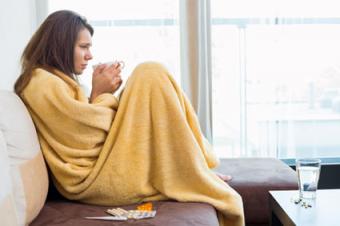
When you abruptly stop or reduce habitual use of opiate drugs, the symptoms of withdrawal can be unpleasant and difficult to cope with. Prescription medicines can relieve these symptoms while your brain and body adjust to being without the drug. If these are not available to you, try some home and over-the-counter remedies to ease you through the opiate withdrawal.
Prescription Withdrawal Medicines

Prescription medicines can relieve opiate withdrawal symptoms, which occur when habitual use creates physical dependence on the drug. Physical dependence means normal bodily function requires continued use of the opiate. These medications either substitute for the opiate, or they block the withdrawal symptoms caused by overproduction of noradrenaline, according to Dialogues in Clinical Neurosciences. You can get these medicines either as an inpatient or an outpatient, depending on your circumstances.
Methadone
During opiate withdrawal, methadone reduces your drug craving and other symptoms, improving the chance that you will successfully stay off opiates. Methadone is an opiate that binds to the same opioid receptors in the brain that abused opiates do, but it has a milder and longer lasting effect on the brain.
You take methadone by mouth once a day. To avoid withdrawal symptoms from stopping methadone suddenly, the dose is gradually reduced to zero. On the other hand, you may be left on a maintenance dose if you are to continue on methadone as part of a drug addiction treatment program.
One downside is that in the United States, if you are doing outpatient methadone withdrawal or methadone maintenance treatment, you have to go to an approved Food and Drug Administration (FDA) treatment program every day to get it. With inpatient therapy you complete opiate withdrawal in five to seven days, while outpatient treatment takes longer to complete, according to the Dialogues in Clinical Neurosciences reference.
Buprenorphine
Like methadone, buprenorphine is also a weaker acting opiate that decreases the craving for your usual drug and relieves other withdrawal symptoms. In small doses, it only partially occupies opioid receptors and produces a milder and more lasting opiate effect on the brain than the abused opiates.
Buprenorphine is taken three times a day sublingually, which is accomplished by placing the tablet under your tongue and allowing it to dissolve. The dose is gradually reduced during one week. Withdrawal symptoms tends to decrease more quickly than with methadone treatment. The other advantage over methadone is that it is approved by the FDA to be prescribed privately from a doctor's office. A downside is that buprenorphine can initiate withdrawal symptoms if given too soon before someone starts withdrawing from the effects of their opiate.
Clonidine
Clonidine, a blood pressure medicine, treats the physically distressing noradrenaline-related symptoms. It binds to receptors on nerve cells in the locus coeruleus area of the brain that produce noradrenaline. This decreases the revved up noradrenaline production induced by your opiate. It also binds to other noradrenaline receptors in other organs. By these mechanisms, clonidine lessens some of the classic signs and symptoms of opiate withdrawal such as sweating, tremors, irritability, increased heart rate, nausea, and vomiting.
Clonidine is taken once a day by mouth. The dose is not tapered, and you take it until the withdrawal phase is over. Though effective for relief of many symptoms, clonidine is less effective than methadone and buprenorphine. It may not relieve insomnia, muscle aches, and restlessness effectively, and it may cause low blood pressure. Lofexidine, a medicine derived from clonidine, is used in the United Kingdom and is effective for relieving symptoms. It has a lower risk for causing low blood pressure.
Other Prescription Medicines
Other medicines treat symptoms that methadone, buprenorphine, and clonidine don't cover, including:
- Prescription sleep medicines, such as clonazepam and trazodone, improve your sleep difficulties and might also help anxiety and irritability.
-
Anti-nausea medicines, such as prochlorperazine (Compazine) or ondansetron, treat the troubling nausea and vomiting.
At-Home Remedies

If you can't get to a treatment facility or a doctor, home and over-the-counter (OTC) remedies can help give you some opiate withdrawal relief. Your best strategy is to choose remedies that are known to help specific symptoms that come from withdrawing opiates.
Hot and Cold Sweats
Try taking as many warm baths as you need if you are chilled, but for safety, try not to fall asleep in the bathtub. Use cold cloths or ice packs if you are hot and sweaty. Drink at least ten glasses of fluids a day to replace what you lose from sweating. This will also help eliminate any opiates from your body.
Anxiety, Irritability, and Depressed Mood
To help you cope with anxiety and irritability and improve your mood, stress, and sense of well-being, try the following;
- Practice relaxation techniques, such as meditation, deep breathing, or visualization.
- If you can, ask someone to give you a whole body massage.
- Be sure to get out of bed and go out for walks as soon as the most acute symptoms improve.
These remedies help by increasing your own natural opiates (endorphins) and reducing your stress hormones, such as cortisol and adrenaline.
Nausea and Vomiting
Natural remedies, such as ginger and peppermint, are frequently used to relieve an upset stomach or nausea. Drink a cup of warm ginger tea or peppermint tea two or three times a day. Tea bags are easy to use, or add a teaspoon of fresh ginger or dried peppermint leaves to a cup of hot water. You can also try chewing on a piece of ginger. Again, drink as much fluid as you can tolerate to replace what you lose. Additionally, eat some probiotic yogurt to replace the good bacteria in your gut. Try to avoid OTC anti-nausea medicines, such as Dramamine.
Diarrhea and Abdominal Cramps
OTC preparations, such as Imodium, decrease diarrhea by slowing down bowel contractions. This will therefore help to improve your bowel cramps. In addition, replace lost fluids and electrolytes with solutions, such as Pedialyte or Gatorade.
Anorexia
An upset stomach, nausea, and vomiting can decrease your appetite. To help settle your stomach, try broths and an easy-to-digest diet of bananas, rice, applesauce, and toast (BRAT diet), recommended for children and pregnant women with morning sickness.
Low Energy
Boost your low energy by improving your diet as soon as your distressed, hyperactive bowel symptoms start settling. Add some Greek yogurt throughout the day for protein and energy. Gradually add more light protein, such as fish and chicken, and more carbs. Additionally, take a daily multivitamin to get enough vitamins and minerals until you are eating better.
Poor Sleep
Insomnia and poor sleep quality can be big problems during opiate withdrawal, especially during the first three days. Try meditation and relaxation, as well as a warm glass of milk before going to bed. Try not to take OTC sleep aids like Benadryl. If you must take something, ask your doctor for a few days of a prescription sleep medicine.
Drug Craving
Drug craving can also be a huge problem during withdrawal, depending on the severity of your drug habit. Craving increases your risk of restarting your opiate. There are no OTC medicines that can reduce craving. Stay positive that your symptoms will pass. Focus on your goals of feeling better and getting off your drugs to help yourself cope mentally with your craving. When you chose to withdraw from your drugs without professional help, gradually decreasing your dose to nothing will decrease your chance of severe drug craving, as opposed to stopping abruptly.
Gradual Improvement
If you are using short acting opiates, such as heroin or Vicodin, by day three your symptoms should start improving and by day five to seven you will feel less ill. Longer acting opiates, such as Oxycontin, will take longer to withdraw from.
Herbal Medicines
There is no reliable data on the efficacy and safety of any herbal or other "natural" preparations or cocktails that are being offered for opiate withdrawal relief. Take such things at your own risk.
A Need for Support
Opiate withdrawal symptoms can be distressing physically and mentally, especially if you are going it alone without prescription medicines. Ask your family or friends to support you through the withdrawal. Call your doctor if you don't start to feel better after the first three to seven days of withdrawal, or you can't cope with your symptoms without medical support.







